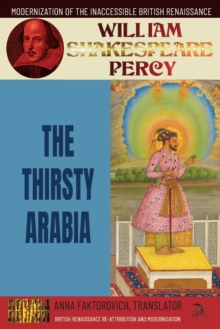A closeted first attempt to present the complexities and elegance of the Islamic faith and the prophet Muhammad on the English stage.
Thirsty Arabia was written over a century before the first English translation of the Qur'an was published. Despite this shortfall in primary sources about Islam, this comedy incorporates with unbiased research a wealth of theological and cultural details. Information flowed into Britain from Muslim countries alongside general trade in goods after Pope Pius V excommunicated Elizabeth I in 1570, but trade was halted shortly after this play was written in 1603. The narrative is launched when Muhammad declares he will destroy all mortals in Arabia for their sins in forty days with a drought. Muhammad's angelic council objects that there might be good people in the region worth saving, so Muhammad allows Harut and Marut to travel across Arabia disguised as humans to attempt to find any do-gooders to save Arabia. The main romantic entanglement across this plot is the unsuccessful courtship of Marquess of the Deserts Epimenides by most of the eligible bachelors, including two imams (Caleb and Tubal), the wealthy magician astrologer Geber, the two disguised angels (Harut and Marut) and Muhammad himself. While most of the characters are distracted with love, the Arabian people are dying of thirst, and fraudsters such as Cavus work to capitalize on this desperation with tricks such as selling water-licenses. Spirits, magic, time travel and fortune telling are used to gain favor and preferment, while angels and good spirits punish evil-doers. The Aristotelian "Square of Opposition" in a logic game the angels play with Muhammad is only one of the many educational and entertaining devices. The poetic, wooing love songs, and witty refusals alone are sufficient for readers to explore the surprises along this narrative.
William Percy (1567?-1648) is the dominant tragedian behind the "William Shakespeare" pseudonym according to the computational-linguistic study in The Re-Attribution of the British Renaissance Corpus. Percy was a younger son of the assassinated 8th Earl of Northumberland and the brother of the imprisoned in the Tower 9th Earl.
This series solves most of the previously critically discussed mysteries concerning the authorship of British Renaissance texts (including the "William Shakespeare" and 103 other bylines) by applying to 284 of them a newly invented for this study computational-linguistics method that uses a combination of 27 different tests to derive that six ghostwriters were their authors: Richard Verstegan, Josuah Sylvester, Gabriel Harvey, Benjamin Jonson, William Byrd and William Percy. This computational method as well as structural, biographical and various other attribution approaches that led to the attribution conclusions are discussed in Re-Attribution of the British Renaissance Corpus. A larger portion of this series is Modernization of the Inaccessible British Renaissance, which tests the quantitative attribution-conclusions by closely analyzing and explaining the contents of re-attributed texts that are uniquely significant for the revised history of this period, and yet have never been translated into Modern English before. Some of these texts were initially anonymous, others were self-attributed by the ghostwriters, and yet others were credited in bylines to pseudonyms or ghostwriting-contractors. The annotations to each of their translations provide thousands of new confirming clues of shared authorship within a given authorial-signature. These texts are polished for the first time to allow their superiority to shine so that readers can see how they rival the standard "Shakespeare" canon.

